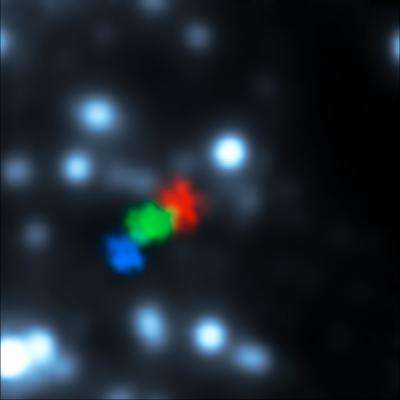VLT watches in real time as gas cloud makes closest approach to the monster at the centre of the Milky Way

In 2011 ESO's Very Large Telescope (VLT) discovered a gas cloud with several times the mass of the Earth accelerating towards the black hole at the centre of the Milky Way (eso1151. This cloud is now making its closest approach and new VLT observations show that it is being grossly stretched by the black hole's extreme gravitational field.
"The gas at the head of the cloud is now stretched over more than 160 billion kilometres around the closest point of the orbit to the black hole. And the closest approach is only a bit more than 25 billion kilometres from the black hole itself—barely escaping falling right in," explains Stefan Gillessen (Max Planck Institute for Extraterrestrial Physics, Garching, Germany) who led the observing team . "The cloud is so stretched that the close approach is not a single event but rather a process that extends over a period of at least one year."
As the gas cloud is stretched its light gets harder to see. But by staring at the region close to the black hole for more than 20 hours of total exposure time with the SINFONI instrument on the VLT—the deepest exposure of this region ever with an integral field spectrometer —the team was able to measure the velocities of different parts of the cloud as it streaks past the central black hole.
"The most exciting thing we now see in the new observations is the head of the cloud coming back towards us at more than 10 million km/h along the orbit—about 1% of the speed of light," adds Reinhard Genzel, leader of the research group that has been studied this region for nearly twenty years. "This means that the front end of the cloud has already made its closest approach to the black hole."
The origin of the gas cloud remains mysterious, although there is no shortage of ideas. The new observations narrow down the possibilities.
"Like an unfortunate astronaut in a science fiction film, we see that the cloud is now being stretched so much that it resembles spaghetti. This means that it probably doesn't have a star in it," concludes Gillessen. "At the moment we think that the gas probably came from the stars we see orbiting the black hole."
The climax of this unique event at the centre of the galaxy is now unfolding and being closely watched by astronomers around the world. This intense observing campaign will provide a wealth of data, not only revealing more about the gas cloud [6], but also probing the regions close to the black hole that have not been previously studied and the effects of super-strong gravity.
This research was presented in a paper "Pericenter passage of the gas cloud G2 in the Galactic Center", by S. Gillessen et al, to appear in the Astrophysical Journal.
More information: www.eso.org/public/archives/re … eso1332/eso1332a.pdf
Journal information: Astrophysical Journal
Provided by ESO





















